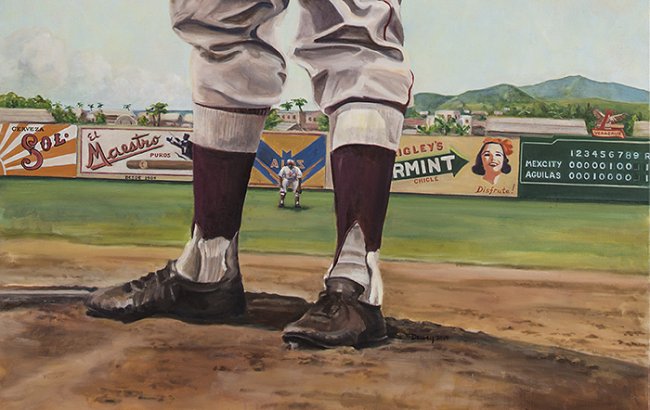
|
El Maestro: Martin Dihigo
2015 oil on canvas with wood 38 x 84 Collection of the National Pastime Museum, San Francisco, CA |
|
Cuban-born Martin Dihigo is considered by many baseball historians to be the most versatile baseball player to ever put on a uniform. His career in the United States began as a second baseman with Alex Pompezâs New York Cubans in 1923, the inaugural year of the Eastern Colored League. He later moved to the corners and then the outfield and, finally, the pitcherâs mound. At the plate he hit for high average and power to spare, leading the league in home runs twice in 1926-27 and hitting .421 and .370, respectively. In fact, Dihigo had only a couple seasons in the more than twenty years of Negro and Latin Leagues play where he didnât hit over 300.
Dihigo made the transition to the mound in the mid 1930âs in conjunction with yet another position as player-manager. It was during this decade that he would also return to play almost exclusively in the Mexican and Latin American Leagues. There he began to concentrate on his pitching and became one of the best hurlers in the Caribbean. Yet his bat never cooled down. Consider his 1938 Mexico League numbers where he led with a .387 batting average while also topping all hurlers with an 18-2 record and a bedrock ERA of 0.90. With such mastery on both sides of the plate he became known as âEl Maestro.â
This painting is loosely based on a story I read about a Mexican Summer League game in which Dihigo pitched for the Veracruz Aguilas against the Agrarios, a team fronted by the sensational American import, Satchel Paige. The two men, both in their mid-thirties, dueled in the blistering Mexican sun for eight innings, deadlocked at 1-1. Paige wilted, and in the ninth his reliever came in to face the Aquilaâs star batsman who promptly crushed a walk-off home run deep over the centerfield fence. âEl Maestroâ had delivered another masterful performance. Martin Dihigo returned to his native Cuba after baseball and lived out his days a national hero, recognized everywhere he went. He died in 1971, and was inducted into the National Hall of Fame in 1977.
Dihigo made the transition to the mound in the mid 1930âs in conjunction with yet another position as player-manager. It was during this decade that he would also return to play almost exclusively in the Mexican and Latin American Leagues. There he began to concentrate on his pitching and became one of the best hurlers in the Caribbean. Yet his bat never cooled down. Consider his 1938 Mexico League numbers where he led with a .387 batting average while also topping all hurlers with an 18-2 record and a bedrock ERA of 0.90. With such mastery on both sides of the plate he became known as âEl Maestro.â
This painting is loosely based on a story I read about a Mexican Summer League game in which Dihigo pitched for the Veracruz Aguilas against the Agrarios, a team fronted by the sensational American import, Satchel Paige. The two men, both in their mid-thirties, dueled in the blistering Mexican sun for eight innings, deadlocked at 1-1. Paige wilted, and in the ninth his reliever came in to face the Aquilaâs star batsman who promptly crushed a walk-off home run deep over the centerfield fence. âEl Maestroâ had delivered another masterful performance. Martin Dihigo returned to his native Cuba after baseball and lived out his days a national hero, recognized everywhere he went. He died in 1971, and was inducted into the National Hall of Fame in 1977.







